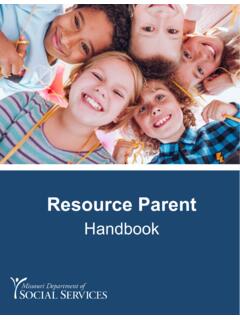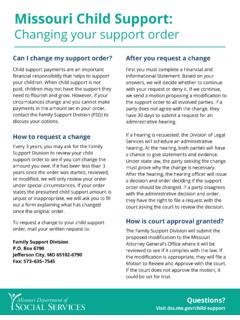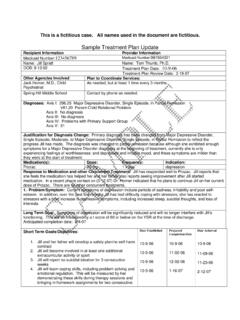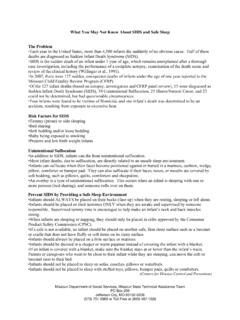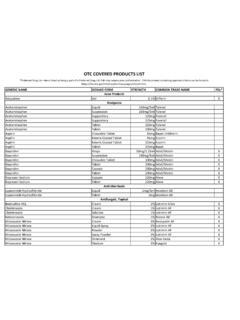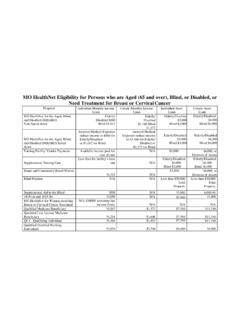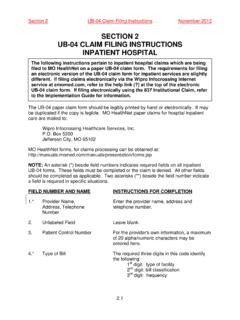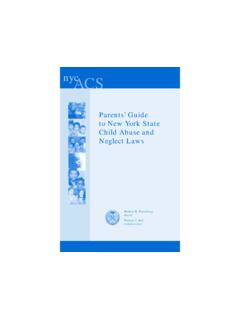Transcription of Department of Social Services Frequently Asked Questions ...
1 Department of Social Services Frequently Asked Questions : child abuse /Neglect Investigations _____ How does the Children s Division respond to a report of child abuse or neglect? The Children s Division often learns of child abuse and neglect when a report is made to the child abuse and Neglect Hotline. The Children s Division responds to all reports alleging child abuse and neglect, and the safety of the child (ren) is our top priority. Once a report has been received, a Children s Division worker will verify the safety of the child (ren) and provide appropriate Services . The Children s Division coordinates with local law enforcement and other agencies in efforts to protect the child (ren) when necessary. The steps taken to protect a child are determined on a case-by-case basis.
2 For more information about the child abuse and Neglect Hotline and the steps taken once a report is received, visit . What circumstances are required for there to be a child abuse and Neglect report ? In order for the Children s Division to accept a hotline report of abuse or neglect for investigation, the child must be under 18 years of age, the alleged perpetrator must have care, custody or control of the child and the allegations must meet the legal definitions of abuse or neglect. The child abuse /Neglect Hotline Unit screens the reported information to determine whether it meets criteria for a child abuse /neglect investigation or a family assessment response. If the Children s Division cannot take the hotline call as a report , does it mean that the Children s Division cannot take any action?
3 No. Even if the report does not meet the criteria for an investigation, the Children s Division has a number of other options that may be appropriate, such as referral to law enforcement, referral to the juvenile officer, handling the case as a family assessment and/or offering Services to the family on a voluntary basis. The decision as to what action is appropriate in a specific case is made on a case by case basis based on the applicable law and facts. What is the difference between an investigation and a family assessment? The initial responsibility of both an investigation and a family assessment is to ensure safety of children. Both approaches are non-punitive and are directed towards assisting families in providing adequate care and nurturance for their children.
4 Assessments can be converted to investigations and vice versa depending on the facts of the case. An investigation is a response to a report of child abuse or neglect when there is an identified need to collect physical and/or verbal evidence to determine if a child has been abused or neglected and to decide whether an individual should be listed in the Central Registry. Investigations are co-investigated with law enforcement when possible. Investigations primarily include reports of child fatality, sexual abuse , serious physical abuse , serious neglect and reports of child abuse or neglect involving foster parents and institutions such as schools, residential facilities and child care centers. A family assessment is a response to a report of child abuse or neglect that does not focus on whether a specific individual should be listed in the Central Registry as a perpetrator of child abuse or neglect.
5 Instead, the focus of an assessment is on working with the child and the child s family to identify factors that may place the child at risk of future abuse and neglect, and to offer voluntary, community based Services to reduce the risk and support the family. Family assessments typically include mild or moderate reports of physical abuse or neglect, including medical neglect and educational neglect. What is a newborn crisis assessment? Newborn Crisis Assessments are calls of concern about the health and safety of newborns, typically because of drug exposure or the capacity of a caregiver to meet the needs of the infant. What is the Central Registry? The Central Registry is a confidential list of persons that the Children s Division keeps who are legally responsible for child abuse or neglect, or who have committed certain crimes involving children.
6 Why doesn t DSS immediately respond to Questions or provide information specific to a child abuse or neglect case? Generally, records of child abuse and neglect are confidential by law and not subject to release. There is an exception for cases of child fatality or near-fatality. For more information about responses regarding a child fatality or near-fatality, visit child abuse and neglect investigations can be time consuming and complex. They Frequently require the Children s Division to rely on work done by other agencies, such as law enforcement. Information developed early on in the investigation may be inaccurate, misleading or contradicted by evidence uncovered later in the investigation. It may take some time for law enforcement and forensic experts to complete their analysis of the evidence and issue their report before the Children s Division can complete its investigation, assess all of the evidence and issue a report .
7 The premature release of information pertaining to an investigation can have an adverse impact on the outcome of an investigation. It can also adversely impact the children and families involved in the investigation. Why can t DSS at least confirm or deny involvement in a child abuse or neglect case? According to Missouri law, all reports, records, and information related to a child abuse and neglect case are closed and confidential, with cases of fatality or near fatality being the only exception, for individuals who are not involved in the matter. By confirming or denying involvement in a case, the Department would be releasing information that is considered confidential. These reports and records are kept closed and confidential in order to protect the privacy of the family and the child .
8 Why can t DSS release information regarding a child s custody/current placement? Just as we cannot confirm or deny involvement in a case, the location of the child (ren) involved in a child abuse and neglect case is a detail that is kept confidential in order to protect the child (ren) and any siblings involved in a child abuse and neglect case. Is there another place to obtain information about the cases of abused or neglected children who are the subject of juvenile court proceedings? Yes. Individuals who have an interest in obtaining information about a juvenile case can submit a request to the Juvenile Court for information about the case. Some Juvenile Court hearings are open to the public. For information on what information may be available and how to ask for it see Missouri Supreme Court Rules and When custodial parent(s) are arrested, what happens to the child (ren)?
9 Once the Children s Division is notified that assistance is needed in locating an appropriate caretaker, law enforcement and Children s Division staff work together to ensure that the child is safe. Appropriate action to protect the child is determined on a case-by-case basis based on the law. If a report of child abuse or neglect is received in relation to the incident or arrest the Children s Division will conduct a hotline investigation or a family assessment. The Children s Division does not have the authority under state law to take a child into custody. Under Missouri law, the final decision to remove a child from the parent s custody can only be made by a Juvenile Court judge. If there is a concern that a child may be in imminent danger, then a law enforcement officer, a physician, and a juvenile officer have the authority to place a child in temporary protective custody.
10 Who determines a child should be removed from a home? Under Missouri law, the final decision to remove a child from the parent s custody can only be made by a Juvenile Court judge. If there is a concern that a child may be in imminent danger, then a law enforcement officer, a physician, and a juvenile officer have the authority to place a child in temporary protective custody. What is the difference between the Juvenile Office and the Children s Division? Are Juvenile Officers part of the Children s Division? No, the Juvenile Office and the Children s Division are two separate agencies. The Juvenile Office is a judicial branch agency. Officers of the Juvenile Court may also be employed by the County. The Children s Division is a completely separate agency in the executive branch of government.
